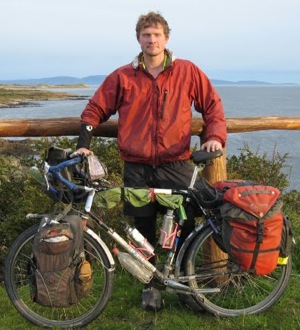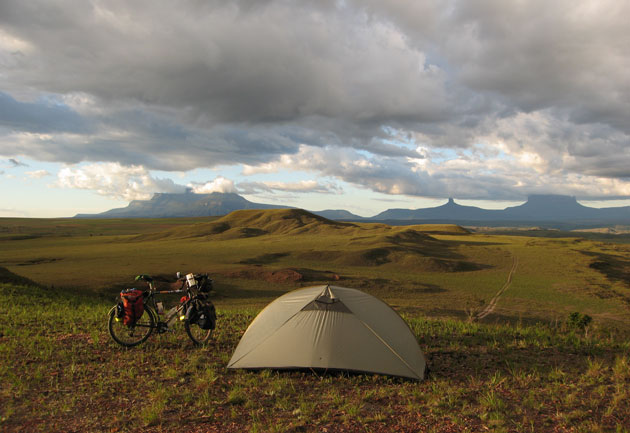Full disclosure: San Francisco-based climate journalist, scientist and educator David Kroodsma is my friend. I will also disclose that I have never gotten over my awe at his incredible 17-month, 16,000-mile bicycle journey from Palo Alto to the southern tip of Tierra del Fuego, an awe compounded when I learned that from Tierra del Fuego he flew to Massachusetts and then rode his bicycle back to California from there. Over the two years of his trip he spoke in dozens of schoolhouses and television studios about climate change and local environments. And now he’s written a book based on his journey. I caught up with him by email to talk about nature-by-bike, climate science, and his ongoing quest for roads to conquer. –Eric Simons

ES: OK, well, obvious question first: Why ride a bike from Palo Alto to Tierra del Fuego?
DK: Between my sophomore and junior years at college, I biked from Portland, Oregon to Palo Alto with a friend. I was hooked. It was such a fantastic experience, a full sensory experience to see the world pan by at 10 miles per hour, and to feel the wind, sun, and even rain.
On that trip, we briefly met another cycle tourist who said he’d once taken off two years and biked to Patagonia. The idea stuck with me, and I later read online about adventurers who had cycled from North America to Argentina, and nearly every one said it was the best thing they’d done in their entire lives. From that point on I saved, planned, and dreamed.
ES: The logistics of this seem impossible. Where did you sleep? What if your bike broke? Aren’t there some rather large hills in the way?
DK: If you know how to ask for a place to camp in Spanish, have camping gear, and a reliable bike, it’s remarkably easy. In the countryside, I either camped behind people’s homes, or hid off the road in the wilderness. In medium sized cities, I often stayed at fire stations, as firefighters in Latin America sometimes take in travelers. In big cities, I usually stayed with people I’d contacted through my project, Ride for Climate. Over nearly two years of travel, I stayed at about 100 homes and slept at almost 40 fire stations. It was a great way to meet people!
As for the bike, I used a bike that was actually made here in the Bay Area. Bruce Gordon, a frame builder based out of Petaluma, makes incredibly durable touring bikes—and ones with gearing low enough to climb over the Andes.
ES: And then you got back to the United States and rode across the country. Weren’t you tired of riding at that point? What more was there to accomplish?
DK: Ha! Yes, I was a bit tired of biking. Although my original motivation for the trip was adventure, I decided to draw on my background in climate science and use the trip to Argentina to raise awareness of climate change. The trip through Latin America was much more successful than I expected – I appeared in the national media of almost every country I visited, and spoke at dozens of schools.
Given that the United States is one of the most important countries with regards to climate change, and given that I was having success, I decided to ride across my own country and continue the project.
ES: It’s a hell of an adventure, but you have a serious point: you’ve got a degree in climate science and went looking both for ways the world is changing and ways people are responding locally. What did you find?
DK: It’s fascinating to talk to people about climate change in 16 different countries. Interestingly, people in Latin America are generally more concerned about climate change than U.S. citizens—polls (and my informal survey) showed that most people in Latin America, even if they don’t understand what climate change is, fear that it will cause them harm. In the U.S., concern is much lower.
In some regions people are very aware that the climate is changing. Many people in Central America told me that the weather had become more variable in recent years. People in the Andes told me that the snowline had been moving up the mountainside.
My two biggest realizations were, in some ways, not new realizations at all. They were obvious, but my bike trip made them personal.
First, much of our world, and the livelihoods of many people, are at risk from climate change. Some absolutely amazing ecosystems and beautiful mountain glaciers might not be here later in our lives. And many people around the world, and especially those living near the coastlines or off the land, are vulnerable to a changing climate.
Second, much of the world lives far more simply than we do in the United States. You could call them poor. And they rightfully want to use more energy and resources, and not less. About a third of the world lives on only two dollars a day. It’s only fair for these people to be able to use more energy. Somehow, we have to figure out how to provide the world with energy without climate change spiraling out of control.
ES: What was it like riding back into the Bay Area?
DK: Well, one challenge to answering this question is that the Bay Area is just so big! I arrived in Santa Rosa, and then still had two days of biking until reaching the Golden Gate Bridge, and one day after that to reach Palo Alto.
It was, though, a fantastic return. About 25 people joined me for biking across the Golden Gate. Someone had speakers on their bike and played “If you’re going to San Francisco, be sure to wear some flowers in your hair.” (Admission: that person was me.) We gave a presentation on the trip at Sports Basement, and then had a party at a friend’s house in the Marina.
The next day, I biked to Palo Alto, and pedaled to the home I’d started out from. I no longer knew who lived there; my friends had moved out. I knocked on the door and had the woman who lived there take a picture of me. It was fairly anticlimactic, but it was good to be back.
ES: What did your travels teach you about climate change here at home?
DK: I think it’s helped put how I live in perspective, and made me feel more connected to the rest of the world. When I see boats travel through the Golden Gate, I can envision some parts of the globe where they are traveling. I can now envision those boats traveling through the Panama Canal, because I’ve been there, or traveling up the Amazon River to Manaus, Brazil. We’re all in this together, even though most of us spend most of our time in the town where we live.
ES: Can you see climate change impacts by bike without leaving the Bay Area?
DK: It can be tough to attribute some changes to climate change, but change is here. This incredibly dry year may very well have been exacerbated by climate change—and it’s likely that much of the West, and especially the Southwest, will become drier in coming decades.
Sea level in the Bay has already risen about seven inches in the last century, and is on pace to rise much more. During our highest tides, you can see what “normal” will look like in the future.
ES: You’ve been, when you’re not on the road, a Bay Area resident for more than a decade. How does biking in our region compare to places you’ve visited out in the wide world?
DK: Easy question. The hills around the Bay Area provide some of the best biking anywhere. (I like to tell people that I’ve done the survey, and the best biking is here).
ES: What’s your favorite local ride?
DK: I’ll pick two. The “Hamilton Century” ride, which takes you over the top of Mt. Hamilton, and then along fifty miles of traffic free roads, including an excellent 20 mile gradual descent through a canyon along Mines Road. The only problem with the ride is that it is too hot in the summer, and in the winter there isn’t enough daylight.
The other is the “Pescadero Loop” which takes you up Old La Honda Road from Portola Valley, down Highway 84, and along Pescadero Road to Pescadero, where you get to eat artichoke bread. From there, follow Stage Road, climb up Tunitas Creek, and then down Kings Mountain Road. It doesn’t get much better than that.
ES: Where did you pick up your love of the environment — and this habit of trying to see it all by bicycle?
DK: I biked some with my dad growing up; he was the one who first introduced me to cycling. In some ways, I don’t like to link biking and environmentalism too strongly. I don’t bike because it’s good for the Earth—I bike because it’s fun, healthy, and in my opinion, the best way to get around many cities and see the world. That said, I’m glad it’s good for the planet too!
In terms of environmentalism, it probably helped that my dad studied birds for a living. In fact, well before this bike trip to Argentina, he and I biked across the U.S. and he recorded bird songs the entire way.
ES: What’s the next big trip?
DK: My wife and I will be biking across Asia starting in April of this year. We’ll be doing a similar project to my South America trip, and we’ll be blogging about climate (and, in particular, water) issues of the region at rideforclimate.com. You can follow our trip there.
David Kroodsma is a San Francisco-based climate journalist. Follow his climate rides at RideforClimate.com His book is available for purchase here.


